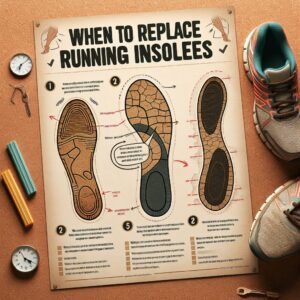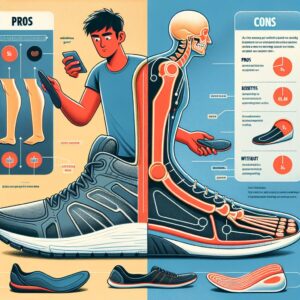
Soothing Your Steps: The Ultimate Guide to Insoles for Arch Pain
-
Table of Contents
“Soothing Your Steps: The Ultimate Guide to Insoles for Arch Pain” is an informative resource designed to provide comprehensive insights into the world of insoles specifically designed to alleviate arch pain. This guide explores the causes of arch pain, the importance of proper foot support, and the role of insoles in providing relief. It offers detailed reviews of various insoles available in the market, their features, and how they can be used to mitigate discomfort. The guide also provides practical advice on choosing the right insoles based on individual needs and lifestyle. Whether you’re an athlete, a professional who spends long hours on their feet, or someone dealing with chronic foot pain, this guide serves as a valuable tool to help you understand and manage arch pain effectively.
Understanding Arch Pain
Arch pain, a common foot condition, can be a significant impediment to daily activities. It is often experienced as a burning or throbbing sensation in the arch of the foot, and can be caused by various factors such as overuse, injury, or medical conditions like plantar fasciitis or flat feet. Understanding the nature of arch pain and how to alleviate it is crucial for those who suffer from this condition.
The human foot is a complex structure composed of 26 bones, 33 joints, and more than 100 muscles, tendons, and ligaments. The arch of the foot, a curved structure formed by these bones and tissues, plays a vital role in supporting body weight and facilitating movement. However, when the arch is subjected to excessive stress or strain, it can lead to arch pain. This can occur due to prolonged standing or walking, wearing inappropriate footwear, or participating in high-impact activities like running or jumping. Additionally, certain medical conditions such as obesity, diabetes, and arthritis can also contribute to arch pain.
The severity and duration of arch pain can vary widely. Some people may experience mild discomfort that subsides after rest, while others may suffer from chronic pain that persists despite rest and medication. In some cases, arch pain can be so severe that it interferes with walking and other daily activities. Therefore, it is essential to seek medical attention if you experience persistent or severe arch pain.
One of the most effective ways to alleviate arch pain is through the use of insoles. Insoles are inserts that are placed inside shoes to provide additional support and cushioning to the feet. They can be particularly beneficial for people with arch pain as they can help to distribute pressure evenly across the foot, reduce strain on the arch, and provide relief from discomfort.
There are various types of insoles available on the market, each designed to address specific foot conditions. For instance, arch support insoles are designed with a raised area to support the arch and alleviate pressure. Cushioned insoles, on the other hand, provide extra padding to absorb shock and reduce impact on the feet. Orthotic insoles are custom-made devices prescribed by a podiatrist or orthopedic specialist to correct specific foot abnormalities or conditions.
When choosing insoles for arch pain, it is important to consider factors such as the severity of your condition, your foot type, and your lifestyle. For mild to moderate arch pain, over-the-counter insoles may be sufficient. However, for severe or chronic conditions, prescription orthotics may be necessary. It is also important to ensure that the insoles fit properly in your shoes and provide adequate support and comfort.
In conclusion, arch pain can be a debilitating condition that can significantly impact your quality of life. However, with the right understanding and management, it is possible to alleviate the discomfort and regain your mobility. Insoles can play a crucial role in this process by providing the necessary support and cushioning to your feet. Therefore, if you are suffering from arch pain, consider incorporating insoles into your footwear as part of your treatment plan.
The Importance of Proper Foot Support
Foot health is a critical aspect of overall well-being that is often overlooked. One common foot ailment that affects a significant portion of the population is arch pain. This discomfort can be debilitating, hindering daily activities and reducing the quality of life. However, a simple yet effective solution to this problem lies in the use of insoles specifically designed to alleviate arch pain.
The human foot is a complex structure, comprising 26 bones, 33 joints, and more than a hundred muscles, tendons, and ligaments. This intricate network works in harmony to support the body’s weight, absorb shock, and maintain balance. The arch of the foot, a curved structure formed by the tarsal and metatarsal bones, plays a pivotal role in these functions. It acts as a natural shock absorber, distributing the body’s weight evenly across the foot during physical activities.
However, various factors such as age, obesity, injury, or certain medical conditions can compromise the integrity of the foot arch, leading to pain and discomfort. This is where the importance of proper foot support comes into play. Providing the right support to the arch can significantly reduce pain, improve foot function, and enhance overall comfort.
Insoles for arch pain are specially designed foot supports that can be inserted into shoes. They work by redistributing pressure, providing cushioning, and supporting the foot’s natural arch. This not only helps to alleviate pain but also prevents further damage to the foot structure.
Insoles come in a variety of materials, including foam, gel, and plastic. Foam insoles are soft and cushioning, providing excellent shock absorption. Gel insoles, on the other hand, offer superior comfort and pressure relief. Plastic insoles are more rigid and provide a high level of arch support, making them ideal for individuals with severe arch pain or flat feet.
The effectiveness of insoles in alleviating arch pain is well-documented in scientific literature. A study published in the Journal of Foot and Ankle Research found that participants who used insoles reported a significant reduction in foot pain and improvement in function. Another study in the Journal of Orthopaedic & Sports Physical Therapy found that insoles can effectively reduce the strain on the plantar fascia, a thick band of tissue that runs across the bottom of the foot, thereby alleviating arch pain.
However, it’s important to note that not all insoles are created equal. The right insole for you will depend on your specific needs and foot structure. For instance, individuals with high arches may require insoles with more arch support, while those with flat feet may benefit from insoles that offer more cushioning. Therefore, it’s advisable to consult a podiatrist or a foot health professional before purchasing insoles.
In conclusion, insoles for arch pain are a simple, cost-effective solution to a common foot ailment. They provide the necessary support to the foot arch, alleviate pain, and improve foot function. By investing in a pair of quality insoles, you can take a significant step towards better foot health and enhanced comfort. So, soothe your steps and embrace the journey towards a pain-free life with the ultimate guide to insoles for arch pain.
The Power of Insoles for Alleviating Arch Pain

Arch pain, a common foot ailment, can be a significant impediment to daily activities. It can stem from various causes, including plantar fasciitis, flat feet, or simply overuse. Regardless of the cause, one effective solution that has been gaining popularity is the use of insoles. These simple yet powerful devices can provide much-needed relief and comfort, making them an essential tool in the battle against arch pain.
Insoles, also known as foot orthotics, are inserts that are placed inside shoes to provide additional support and cushioning. They are designed to align the foot and ankle into the most anatomically efficient position, thereby reducing the strain on the arch. This can significantly alleviate pain and discomfort, allowing individuals to walk, run, or stand for extended periods without experiencing the debilitating effects of arch pain.
The effectiveness of insoles in alleviating arch pain is backed by a wealth of scientific evidence. Numerous studies have shown that they can significantly reduce pain and improve functional ability in individuals suffering from various foot conditions. For instance, a study published in the Journal of Foot and Ankle Research found that custom-made insoles could reduce pain and improve function in patients with plantar fasciitis. Similarly, research published in the Journal of Orthopaedic & Sports Physical Therapy found that insoles could effectively reduce pain in individuals with flat feet.
Insoles come in a variety of types, each designed to address specific needs. For instance, there are insoles specifically designed for high arches, flat feet, or plantar fasciitis. These are typically made from materials such as foam, gel, or plastic, which provide varying degrees of support and cushioning. Some insoles are custom-made, molded precisely to the individual’s foot to provide optimal support. Others are pre-made and can be purchased over-the-counter. While custom-made insoles are generally more effective, over-the-counter insoles can also provide significant relief and are a more affordable option.
Choosing the right insoles can make a significant difference in managing arch pain. It’s essential to consider factors such as the specific foot condition, the level of support needed, and the type of shoes in which the insoles will be used. For instance, individuals with flat feet may benefit from insoles that provide arch support, while those with high arches may require insoles that offer more cushioning. Similarly, individuals who wear high-heeled shoes may need different insoles than those who wear athletic shoes.
In conclusion, insoles are a powerful tool for alleviating arch pain. They provide additional support and cushioning, align the foot and ankle into an efficient position, and can significantly reduce pain and improve function. Whether custom-made or over-the-counter, insoles can make a significant difference in managing arch pain. However, it’s essential to choose the right insoles based on individual needs and circumstances. With the right insoles, individuals suffering from arch pain can experience significant relief and regain their ability to engage in daily activities without discomfort.
Features to Look for in Insoles for Arch Pain
Arch pain can be a debilitating condition that hinders your daily activities and overall quality of life. It is often caused by plantar fasciitis, a common foot condition that affects the arch of the foot. One of the most effective ways to alleviate this discomfort is by using insoles specifically designed for arch pain. However, with a plethora of options available in the market, choosing the right insole can be a daunting task. This article aims to guide you through the essential features to look for when purchasing insoles for arch pain.
Firstly, the most crucial feature to consider is the level of arch support provided by the insole. The primary function of an insole for arch pain is to provide ample support to the arch of the foot, thereby reducing the strain on the plantar fascia. Insoles with a high arch are generally recommended for individuals with high arches or flat feet, as they provide the necessary support to alleviate pain. Conversely, those with normal arches may find insoles with moderate arch support more comfortable.
Secondly, the material of the insole plays a significant role in its effectiveness. Insoles are typically made from various materials, including foam, gel, cork, and leather. Foam insoles are popular due to their ability to provide excellent cushioning and shock absorption. Gel insoles, on the other hand, are known for their durability and ability to distribute pressure evenly across the foot. Cork and leather insoles are less common but are praised for their natural, breathable qualities. The choice of material largely depends on personal preference and the specific needs of your feet.
Thirdly, the size and fit of the insole are paramount. An ill-fitting insole can exacerbate arch pain rather than alleviate it. Therefore, it is essential to choose an insole that fits your shoe size perfectly. Some insoles are full-length, providing support to the entire foot, while others are three-quarter length and focus on the heel and arch. The choice between full-length and three-quarter length insoles depends on the type of shoes you wear and the extent of your arch pain.
Fourthly, consider the insole’s adaptability. Some insoles are rigid and maintain their shape, while others are flexible and mold to the shape of your foot over time. Rigid insoles are typically more durable and provide consistent support, making them ideal for severe arch pain. Flexible insoles, however, offer a more personalized fit and are generally more comfortable for mild to moderate arch pain.
Lastly, the durability of the insole is a vital consideration. Insoles for arch pain are an investment in your health and comfort, so it’s essential to choose a product that will last. Look for insoles made from high-quality, durable materials and check customer reviews for insights into the product’s longevity.
In conclusion, when choosing insoles for arch pain, it is essential to consider the level of arch support, the material, the size and fit, the adaptability, and the durability of the product. By taking these factors into account, you can find the perfect insole to soothe your steps and alleviate your arch pain.
How to Choose the Right Insoles
Arch pain can be a debilitating condition that affects your daily life, making even the simplest tasks a challenge. One of the most effective ways to alleviate this discomfort is by using insoles specifically designed for arch pain. However, with a plethora of options available in the market, choosing the right insoles can be a daunting task. This article aims to guide you through the process of selecting the perfect insoles to soothe your steps.
Firstly, it is crucial to understand that not all insoles are created equal. They come in a variety of materials, including foam, gel, cork, and leather. Each material has its own set of benefits and drawbacks. Foam insoles, for instance, offer excellent cushioning and support, but they may not be as durable as other materials. Gel insoles, on the other hand, are known for their shock absorption capabilities, but they might not provide the same level of arch support as foam or cork. Therefore, it is essential to consider the material of the insole based on your specific needs and preferences.
Secondly, the type of arch you have plays a significant role in determining the right insoles. There are three main types of arches: high, neutral, and low or flat. High arches require insoles that offer more cushioning to alleviate pressure points, while flat feet need insoles that provide more structure and support. For those with neutral arches, a balance of support and cushioning is ideal. Hence, understanding your arch type is a critical step in choosing the right insoles.
Moreover, the size and fit of the insole are equally important. An ill-fitting insole can exacerbate your arch pain rather than alleviate it. Insoles come in a range of sizes, and some are even trimmable for a custom fit. It is recommended to try on the insoles with the shoes you wear most often to ensure a comfortable fit.
Additionally, it is worth considering the specific features of the insoles. Some insoles are designed with additional padding in the heel or forefoot area, while others have a deep heel cup for added stability. There are also insoles with antimicrobial treatments to prevent odors. These features can enhance the comfort and functionality of the insoles, so it’s worth considering them based on your individual needs.
Lastly, while price should not be the sole determining factor, it is an important consideration. High-quality insoles can be a significant investment, but they are often more durable and effective in relieving arch pain. However, there are also affordable options that offer decent support and cushioning. It’s about finding a balance between quality and affordability that suits your budget.
In conclusion, choosing the right insoles for arch pain involves considering various factors, including the material, arch type, size, specific features, and price. It may require some trial and error, but finding the right insoles can significantly improve your comfort and mobility. Remember, it’s not just about soothing your steps, but also about enhancing your overall quality of life.
Incorporating Insoles into Your Life
Incorporating insoles into your daily life can be a game-changer, especially for those who suffer from arch pain. Arch pain, a common foot condition, can be caused by various factors such as plantar fasciitis, flat feet, or simply standing for extended periods. Regardless of the cause, the discomfort can be debilitating, affecting your mobility and overall quality of life. However, the good news is that the right pair of insoles can provide the much-needed relief and support, soothing your steps and making each stride more comfortable.
Insoles, also known as foot orthotics, are designed to fit inside your shoes, providing additional cushioning and support to your feet. They are particularly beneficial for those with arch pain as they can help distribute pressure evenly across the foot, reducing strain on the arch. Moreover, insoles can correct foot alignment, which can alleviate pain not only in the foot but also in other parts of the body such as the knees and lower back.
When it comes to incorporating insoles into your life, it’s crucial to choose the right pair. Not all insoles are created equal, and the most suitable type for you will depend on your specific needs and the nature of your arch pain. For instance, if you have flat feet, you may benefit from insoles that offer arch support and help realign your foot. On the other hand, if you have high arches, cushioned insoles may be more beneficial to absorb shock and reduce pressure on the arch.
Once you’ve found the right pair of insoles, it’s time to start incorporating them into your daily routine. It’s recommended to wear them consistently for the best results. However, it’s also important to note that there may be an adjustment period. Initially, you might feel a bit uncomfortable as your feet get used to the new support. But don’t worry, this is normal and temporary. Gradually, your feet will adjust, and you’ll start to notice the benefits.
In addition to wearing insoles, it’s also beneficial to pair them with supportive footwear. Shoes that provide good arch support and have a wide toe box can enhance the effectiveness of the insoles, providing maximum comfort and relief from arch pain. Furthermore, it’s advisable to replace your insoles regularly, typically every six to twelve months, depending on the wear and tear.
In conclusion, incorporating insoles into your life can significantly alleviate arch pain, improving your mobility and overall quality of life. By choosing the right pair of insoles, wearing them consistently, and pairing them with supportive footwear, you can soothe your steps and make each stride more comfortable. Remember, it’s not just about relieving pain, but also about promoting foot health in the long run. So, take the first step towards a pain-free life by incorporating insoles into your daily routine. Your feet will thank you.
Additional Tips to Ease Arch Pain
Arch pain can be a debilitating condition that affects your daily life, making every step a painful ordeal. While there are many treatments available, one of the most effective and non-invasive solutions is the use of insoles specifically designed to alleviate arch pain. However, insoles are not a standalone solution. There are additional measures that can be taken to further ease the discomfort and promote healing.
Firstly, it is crucial to understand that not all insoles are created equal. The right insole for arch pain should provide ample support to the arch and distribute pressure evenly across the foot. This helps to alleviate the strain on the arch, reducing pain and discomfort. Insoles made from materials such as memory foam or gel can offer superior comfort and shock absorption. It is also important to ensure that the insoles fit properly in your shoes. Ill-fitting insoles can exacerbate the problem rather than alleviate it.
In addition to using insoles, maintaining a healthy weight can significantly reduce the pressure on your arches. Excess weight can put undue stress on your feet, leading to conditions such as plantar fasciitis and flat feet, both of which can cause arch pain. Regular exercise and a balanced diet can help manage your weight and improve overall foot health.
Stretching exercises specifically targeted at strengthening the foot and calf muscles can also be beneficial. These exercises can improve flexibility, reduce tightness, and help prevent injuries that can lead to arch pain. For instance, exercises such as heel raises, toe curls, and calf stretches can be incorporated into your daily routine. It is advisable to consult with a physiotherapist or a podiatrist to learn the correct techniques and ensure these exercises are done safely.
Footwear also plays a significant role in managing arch pain. Shoes that provide good arch support and have a well-cushioned sole can help reduce the impact on the arches. Avoid wearing high heels or shoes with a narrow toe box as they can put extra pressure on the arches and lead to pain. It is also recommended to replace your shoes regularly as worn-out shoes can lack the necessary support and cushioning.
Applying ice to the painful area can help reduce inflammation and provide temporary relief from arch pain. This can be particularly helpful after a long day on your feet. Simply wrap a few ice cubes in a thin towel and apply it to the affected area for 15-20 minutes.
Lastly, it is important to listen to your body. If you experience persistent arch pain, it is advisable to seek professional help. A podiatrist can provide a thorough examination, diagnose the underlying cause of the pain, and recommend a comprehensive treatment plan.
In conclusion, while insoles can provide significant relief from arch pain, they should be used in conjunction with other measures such as maintaining a healthy weight, doing foot and calf exercises, wearing supportive footwear, applying ice, and seeking professional help when necessary. By taking a holistic approach to managing arch pain, you can soothe your steps and enjoy a more active and pain-free lifestyle.The book “Soothing Your Steps: The Ultimate Guide to Insoles for Arch Pain” provides comprehensive information on how to manage and alleviate arch pain through the use of insoles. It offers valuable insights into the causes of arch pain, the different types of insoles available, and how to choose the right one for individual needs. The guide is a useful resource for anyone suffering from arch pain, providing practical solutions to improve foot comfort and overall health.







